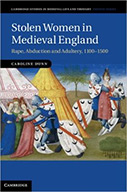Stolen Women in Medieval England: Rape, Abduction, and
Adultery, 1100-1500
 Author: Caroline Dunn
Author: Caroline Dunn
Publisher: New York: Cambridge University Press, 2013. 272 p.
Reviewer: Sam Bieler | September 2013
Drawing on an impressive selection of primary sources, Caroline Dunn’s Stolen Women in Medieval England: Rape, Abduction, and Adultery, 1100-1500, examines male control and female agency through an investigation of several different types of sexual offenses. Drawing from a strong selection of sources, Dunn’s individual chapters offer interesting interpretations of each offense, though it takes some effort on the part of the reader to connect these individual elements to a broader unified narrative.
In each chapter, Dunn reviews a separate facet of English medieval legal culture surrounding key sexual offenses like rape, adultery, or elopement. To support the argument, the narrative draws from both translated and original English legal records as well as fictional works from Chaucer and others. Much of the narrative follows either significant legal developments, like the Westminster Statutes governing offenses such as rape and abduction, or the stories of individual women caught up in a court proceeding on a particular crime.
The result of this careful scholarship is a set of strongly sourced and well developed essays offering the author’s interpretation of the legal status of women in relation to the particular offense. The scope of each piece varies with the topic: some focus exclusively on the English experience, while others expand the area of investigation to develop a comparison between the English and continental experiences. While it is occasionally difficult to follow the thread of these pieces, particularly when the reader is presented with a block of un-translated Latin or old English text, the overall composition of the work, with strongly drawn individual conclusions, is well-thought through.
While each chapter is individually impressive, it can be challenging for a reader to connect each individual element to the narrative whole. The book’s motivating goal is to understand the role of women in the legal system, and how they could maneuver around male-dominated power structures. While some chapters make this claim very clearly, in others, the reader is at pains to figure out why the evidence Dunn presents offers a strong challenge to the prevailing view of medieval women as actors with only limited agency. Thus, by the time the reader reaches the end of the book it is hard to accept any strong conclusions offered about the status of medieval women. While Dunn offers some exceptions to the prevailing view of medieval women as passive actors, the narrative does not offer enough strength to suggest that these incidents represent an actual trend or presence of female agency, but are rather extraordinary, isolated instances.
This however, does not detract from the strength of the individual chapters, which offer interesting treatments of key medieval offenses. Indeed and ironically, the tight focus of each of these chapters allows the author to defend her conclusions more assertively than does the overall narrative of the book. In sum, this book lays a strong groundwork for further review of female agency in the Middle Ages.
Sam Bieler is a Research Associate at the Urban Institute.


